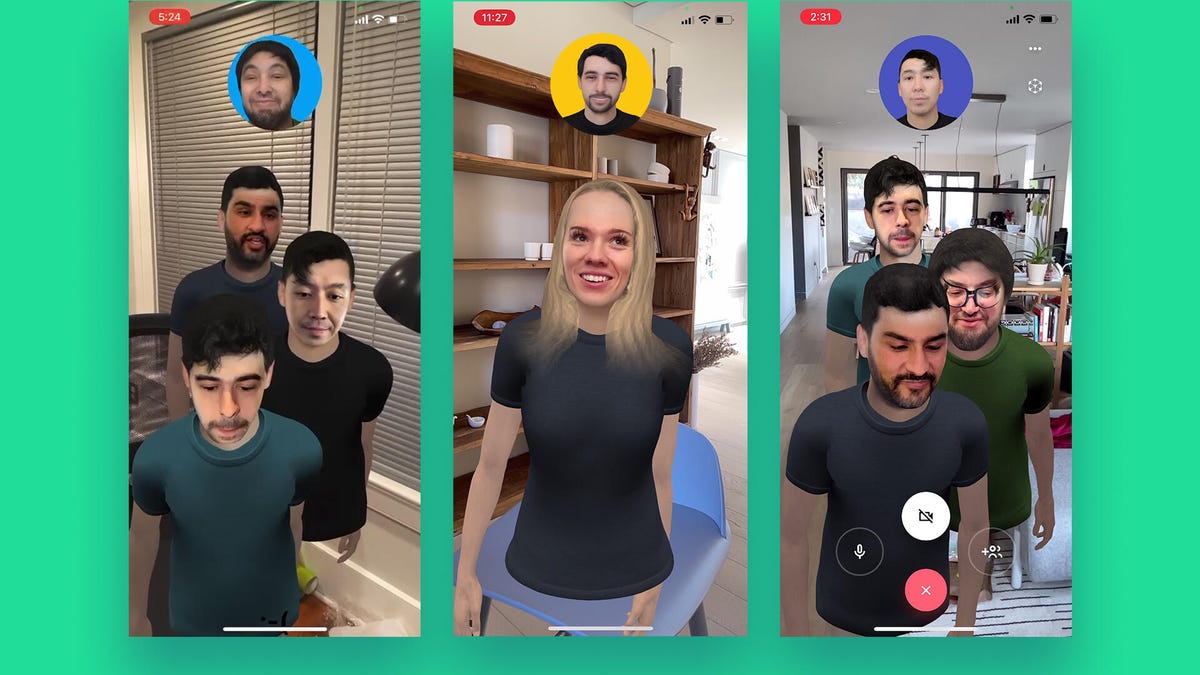 Why You Can Trust CNET
Why You Can Trust CNET Chat app Tele feels like FaceTime built for AR
Exclusive: A new iPhone app from VR/AR company Spatial explores up-close virtual gatherings.

Tele blends avatars and real faces in a chat app. Expect more of this.
When I joined up with executives from Spatial to try a new phone app last Friday night, I was expecting some sort of AR meeting experience where people would seem to float in my virtual space. That isn't exactly what I got. Instead, I felt like I was floating in someone else's space. Or rather, in a third space. Chatting in Spatial's new Tele app, which taps into Apple's AR iPhone capabilities, feels awfully familiar and also very alien. And like something new.
For the last year, I've ping-ponged between Zoom, FaceTime, Google Meet, WebEx, Microsoft Teams, Houseparty, Marco Polo, Facebook Portal, VR hangouts, Roll 20, Animal Crossing and nearly every other implementation of interaction at a distance. Bringing people into one shared chat is an awkward proposition still, even for 2020. Zoom splits everyone into a grid. VR apps replace faces with avatars. Facebook's Portal and Microsoft Teams are exploring layering people with AR effects, or transporting groups into other places like classrooms, but it's early days, still.
Spatial's Tele, which is out now for iPhones with the TrueDepth camera (iPhone X and later), takes all the people you're chatting with and groups them together in one space, overlaying real faces onto avatar bodies. And, oddly, 3D avatar heads blended with real faces. I saw the execs all bundled together, chatting like a bunch of half-cartoon friends. With eyes and mouths and faces that were mostly real. It's... weird!
It sounds unnerving, but it's exactly the stuff I'm used to seeing on filters from Snapchat, just transposed into a phone video-chat app. I'm surprised Snapchat and Facebook's Instagram AR haven't tried this yet, but I bet they will.
Peter Ng, who created the Tele UI, previously worked at Google. "I was leading the design for Google Hangouts aimed at bringing those boring texts and work conversations to life," Ng says. "Seven years later I'm still in pursuit of that mission, except this time in 3D and with teleporting holograms. We're building the office of the future where our SF team and NY team can be together while apart."
Oddly, I got used to it over time. And it bundled people together into one screen, at least, so I didn't have to deal with Zoom-grid. (In the early build I tried, faces weren't always making direct eye contact at my height in AR mode.)
Tele is free, and experimental. It's a spin-off project from Spatial's main app ecosystem, a larger virtual meetings app that blends VR, desktop and phone apps, and phone-based AR. Spatial just launched a phone app this week, an expansion of its VR app that can project people into my home. Spatial's meeting app could eventually fold in the close-up modes that Tele is exploring.
One thing Tele can't do yet is use real faces while avatars are projected into your room with you: Apple's ARKit support currently doesn't allow for a combination of AR and front camera capture together. Someday it probably will. And when those blend, we may get a taste of where virtual collaborative worlds will head next: avatars with actual faces.
Tele is a weird experience right now, but I'd love to see more attempts to blend chat and bring my family together into one screen. Maybe this is the start.

